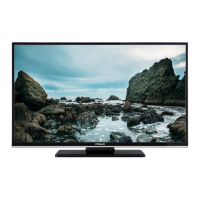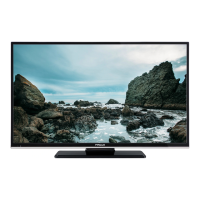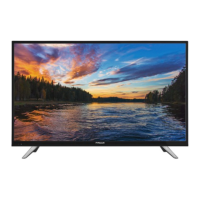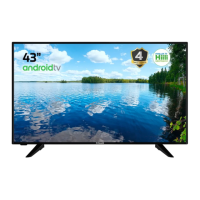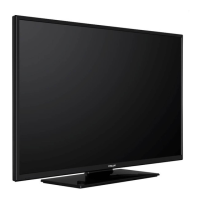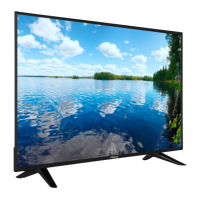Do you have a question about the Finlux 40FLHY930HU and is the answer not in the manual?
Ensures the TV set is operated only from a 220-240 VAC, 50 Hz outlet.
Guidance on safe handling and placement of the power cord to prevent hazards.
Advises against using the device in humid places or near water.
Instructions for safe cleaning using a soft, dry cloth.
Ensures proper airflow by keeping ventilation slots clear for reliable operation.
Warns against placing the set near open flames or heat sources.
Recommends disconnecting power during storms or holidays.
Specifies using manufacturer-approved replacement parts.
Advises referring all servicing to qualified personnel.
Provides guidance on recycling packaging and proper battery disposal.
Ensures the mains plug remains readily operable for disconnection.
Warns that excessive headphone volume can cause hearing loss.
Device must be securely attached to the wall as per instructions.
Explains pixel variations and advises against leaving TV unattended.
Lists the components included in the package: LCD TV, Remote Control, Batteries, and Instruction Book.
Acknowledges trademarks used in the manual.
Provides information regarding licensing.
Warns against unsupervised use of electrical devices by children.
Explains that the standby button does not fully switch off the device.
Technical tip regarding potential radio interference with HDMI.
Details on how the television is designed to consume less energy.
Provides steps to reduce energy consumption, including Power Save Mode.
Explains how to use the Power Save Mode to reduce energy use.
Guidance on servicing and contacting the dealer for repairs.
Details the function of each button on the remote control.
Identifies the physical buttons on the TV set for operation.
Explains SCART 1 and SCART 2 inputs/outputs for external devices.
Details connection for component video and audio signals.
Describes connection for PC audio and component audio.
Connects to external subwoofer and outputs digital audio signals.
Connects to an aerial antenna system for receiving channels.
For connecting a personal computer to the TV set.
For connecting devices with HDMI sockets for high definition.
For inserting a Cl card to view subscribed channels.
Connection point for USB devices.
For connecting external headphones to listen to TV sound.
Connects video and audio signals from external devices.
Connects the TV set to the 220-240V AC, 50 Hz mains socket.
Connects the aerial or cable TV plug to the AERIAL INPUT.
How to connect and use USB devices for displaying files.
Caution regarding quick plugging/unplugging and data loss.
Connects camcorders and other equipment via S-VIDEO or VIDEO IN.
Connects computer for displaying screen image on the TV.
Connects optional equipment like speakers using SPDIF.
Details HDMI, COMPONENT, and SCART connection methods for DVD players.
Instructions for inserting batteries into the remote control.
Guides on switching the TV on and off, including standby mode.
How to switch between different input sources using the SOURCE button.
Operating volume and programme selection using TV set buttons.
Adjusting the volume level using the TV or remote control.
Methods for selecting programmes via previous/next or direct access.
Accessing the Electronic Programme Guide for channel information.
Switching between different AV modes using the AV button.
General guide to operating TV functions with the remote control.
Details on navigating the programme guide using coloured buttons and numeric keys.
Instructions for accessing and using digital teletext features.
Notes that analogue teletext functions are similar to digital.
Guides the user through the initial setup process, starting with language selection.
Configures country, teletext language, and encrypted channel scan options.
Initiates an automatic scan for digital terrestrial TV broadcasts.
Guides setting up for cable scanning with frequency and search step.
Provides options for automatic channel scan, manual scan, and first time installation.
Explains how to perform analogue and digital/analogue auto channel scans.
Guides for direct broadcast entry and manual channel scanning.
Details Digital Aerial, Digital Cable, and Analogue manual search procedures.
Adjusts analogue channels for optimal reception.
Option to clear all stored channels, often country-specific.
Managing the channel list: editing, moving, deleting, and renaming channels.
Locks channels using a parental control PIN to prevent unauthorized viewing.
Creating and managing a list of favourite programmes for easy navigation.
Selects broadcasts to be listed in the channel list by type.
Displays channel and programme details on the information banner.
Accessing and navigating the Media Browser for files on USB devices.
Playing video files stored on a USB memory stick.
Viewing image files stored on a USB memory stick.
Controls for slideshows, playback, rotation, and file sorting.
Playing audio files stored on a USB memory stick.
Configures preferences for the Media Browser, like view style and slide show interval.
Changing aspect ratio (image size) using zoom modes like 16:9, 4:3, Cinema.
Detailed picture settings including Mode, Contrast, Brightness, Sharpness, and Colour.
Descriptions of individual picture settings like Mode, Contrast, Brightness, Sharpness, Colour, etc.
Specific picture settings for PC input, including Position adjustments.
Detailed sound settings including Volume, Equalizer, Balance, and Sound Mode.
Explanations for Volume, Equalizer, Balance, Sound Mode, AVL, Dynamic Bass, Surround Mode.
Accessing the main settings menu for system configuration.
Lists available settings categories: Conditional Access, Language, Parental, Timers, etc.
Instructions for inserting and using a Conditional Access Module (CAM).
Accessing the menu settings for conditional access modules.
Setting preferred language for menus, audio, subtitles, and teletext.
Sets preferred audio, subtitle, teletext, and guide languages.
Prohibits viewing of programmes, channels, and menus using parental control.
Explains menu lock, maturity lock, child lock, and PIN setting.
Setting sleep timers and programme timers for specific events.
Adding, editing, and deleting timers for programme events.
Setting the date, time, time settings mode, and time zone.
Enabling or disabling selected source options for input selection.
Covers menu timeout, encrypted channels, blue background, software upgrade, application version.
Settings for menu timeout, scan encrypted channels, blue background, and software upgrade.
Details TV information display, mute function, picture mode selection, and subtitles.
Explains the function of buttons for activating, mixing, and navigating teletext.
Using coloured buttons for FASTEXT and TOP text systems.
Advice on cleaning the TV screen safely.
Explains ghosting and how to avoid or resolve it.
Troubleshooting steps for when the TV has no power.
Troubleshooting steps for poor picture quality, including aerial and channel tuning.
Troubleshooting steps for when no picture is displayed.
Troubleshooting steps for no sound or sound from only one speaker.
Troubleshooting steps when the remote control is not responding.
Troubleshooting steps for issues with selecting input sources.
Lists typical video display modes and resolutions supported for PC input.
Details supported AV and HDMI signal types and availability.
Lists resolution information for connecting devices via DVI converter cables.
Guides on checking for and performing software upgrades via user interface or automatic mode.
Lists supported file formats for Movie, Music, Photo, and Subtitle via USB.
Provides EU guidance on disposing of old equipment and batteries responsibly.
Details TV broadcasting standards, receiving channels, RF input, and audio.
Specifies panel size, dimensions, weight, and power consumption.
Details DVB-C transmission standards, demodulation, and video/audio formats.
Specifies MHEG-5 ENGINE compliance, DVB-T standards, and reception parameters.
| Screen Size | 40 inches |
|---|---|
| Display Technology | LED |
| Smart TV | Yes |
| HDMI Ports | 3 |
| USB Ports | 2 |
| Wi-Fi | Yes |
| Ethernet | Yes |
| Audio Output | 20W |
| Refresh Rate | 60 Hz |
| Bluetooth | No |
| Energy Efficiency Class | A+ |
| Resolution | 1920 x 1080 |

